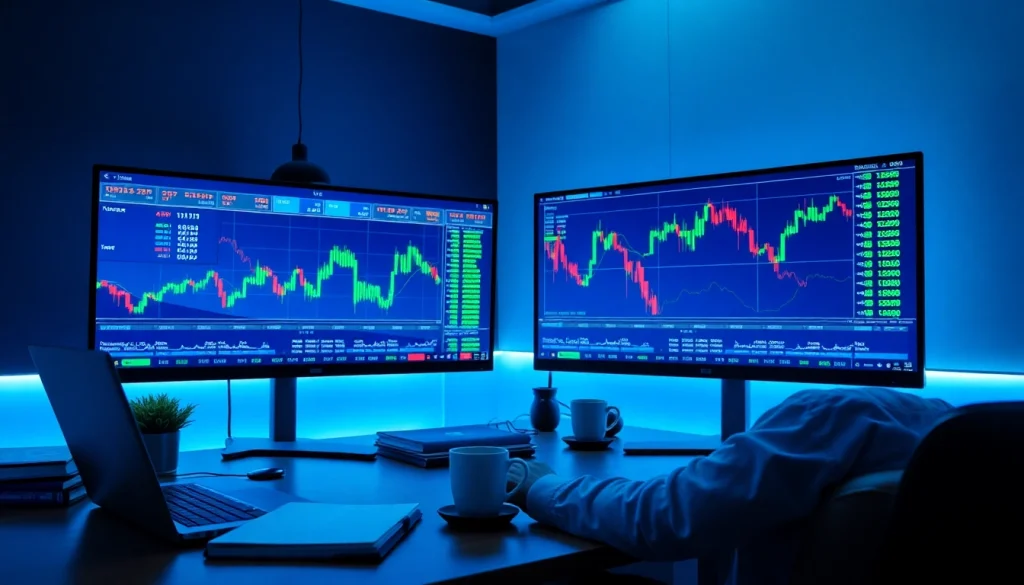
Understanding Forex Trading Basics
Forex trading, commonly known as foreign exchange trading or FX trading, refers to the process of exchanging one currency for another, and it’s vital for international business and investing. As a decentralized global market, the forex market operates around the clock, fueled by the essential demand for currency conversion. In this article, we’ll delve into the depths of forex trading, starting from the foundational concepts to advanced techniques.
What is Forex Trading?
The foreign exchange market is the world’s largest financial market, where currencies of different countries are bought and sold. Unlike stock markets, there is no centralized exchange; rather, trading occurs over-the-counter (OTC), meaning that transactions are conducted directly between parties, often through electronic trading platforms. This dynamic market plays a crucial role in global economics by determining currency values and facilitating international trade and investment.
The Mechanics of Currency Trading
Forex trading involves the simultaneous buying of one currency while selling another. When a trader believes that one currency will appreciate against another, they will buy the base currency and sell the quote currency. For example, if you believe the euro (EUR) will strengthen against the US dollar (USD), you would buy EUR/USD. The value of currency pairs fluctuates based on thousands of factors, including economic data, geopolitical events, and market sentiment.
Key Terms and Concepts in Forex
- Currency Pair: A pair of currencies that are traded against each other (e.g., EUR/USD).
- Pip: The smallest price movement of a currency pair; it is typically the fourth decimal point (0.0001).
- Spread: The difference between the bid and ask price of a currency pair.
- Leverage: A tool that allows traders to control a larger position with a smaller amount of capital, increasing potential returns (and also potential losses).
- Margin: The amount of money required to open and maintain a leveraged position.
Getting Started with Forex Trading
For those looking to dive into forex trading, understanding the setup process is crucial to achieving success. Let’s explore the first steps.
Selecting a Forex Broker
A forex broker acts as an intermediary between you and the market. Your choice of broker can greatly influence your trading experience and success. It is essential to consider the following factors when selecting a broker:
- Regulation: Ensure that the broker is regulated by a reputable financial authority, which offers protection and security.
- Trading Platform: Look for user-friendly platforms with advanced trading tools and features.
- Spreads and Commissions: Compare the costs of trading to ensure they align with your trading strategy.
- Customer Support: Choose a broker that offers reliable customer service for any issues or questions that may arise.
- Educational Resources: A good broker should also provide educational materials, helping both beginners and advanced traders enhance their skills.
Setting Up Your Trading Account
Once you’ve chosen a broker, the next step is setting up your trading account. This usually involves the following:
- Registration: Fill out an online application form with your personal details.
- Verification: Submit required identification documents to verify your identity.
- Deposit Funds: Fund your account using various payment methods, such as bank transfer, credit card, or e-wallet.
Essential Trading Tools and Platforms
After setting up your account, it’s important to familiarize yourself with trading tools and platforms. Most brokers offer robust platforms to help you trade effectively. Essential tools include:
- Trading Platforms: Software used to execute trades, analyze markets, and manage accounts.
- Charting Tools: Innovations that allow traders to view price movements and trends through visual analysis.
- Economic Calendars: Tools that help traders track important economic events that may impact currency values.
Developing a Forex Trading Strategy
A well-thought-out trading strategy is paramount for success in forex trading. This section will outline different approaches you can take.
Technical Analysis Techniques
Technical analysis involves analyzing statistical trends from trading activity, such as price movement and volume. Important components of technical analysis include various tools, such as:
- Support and Resistance Levels: Key price levels that can indicate market interest and potential reversal points.
- Chart Patterns: Recognizable formations on price charts that provide insight into future market movements.
- Indicators: Mathematical calculations based on price, volume, or open interest that provide further insight into market trends.
Fundamental Analysis in Forex
Fundamental analysis focuses on the economic factors that affect currency valuations. Traders assess economic indicators such as GDP, employment rates, and inflation data, as well as geopolitical influences, to forecast price movements. Understanding how these factors interrelate with currency fluctuations is crucial.
Risk Management Best Practices
Risk management is vital to ensure long-term success in forex trading. Key strategies include:
- Setting Stop-Loss Orders: Automatically close a position to limit potential losses.
- Position Sizing: Determine how much of your trading capital to invest in a single trade based on your overall account balance and risk tolerance.
- Diversifying Your Portfolio: Spread investments across various currency pairs to reduce overall risk.
Advanced Forex Trading Techniques
For those who are ready to elevate their trading game, here are advanced techniques to consider.
Utilizing Trading Indicators
Trading indicators can enhance your decision-making process. Some popular indicators include:
- Moving Averages: Used to smooth out price data and highlight trends.
- Relative Strength Index (RSI): Measures the speed and change of price movements, indicating overbought or oversold conditions.
- Bollinger Bands: A volatility indicator that consists of a middle line (moving average) and two outer bands showing standard deviations.
Trading Psychology and Discipline
The mental aspect of trading can be just as important as the technical and fundamental aspects. Maintaining discipline and a calm mindset can prevent emotional decisions that lead to losses. Strategies to improve your trading psychology include:
- Set Realistic Goals: Aim for achievable targets based on your trading style and market conditions.
- Develop a Trading Plan: A structured plan outlining entry and exit points, risk management measures, and market analysis.
- Reflect on Trading Performance: Review your trades regularly to learn from mistakes and successes.
Leveraging Automation in Forex Trading
Automated trading systems or Expert Advisors (EAs) can take emotions out of the trading process and execute strategies based on predefined criteria. While they can enhance trading efficiency, traders must remain vigilant, as market conditions can change rapidly, affecting the performance of automated systems.
Measuring Your Success in Forex Trading
To gauge your progress, it’s important to establish metrics and continuously evaluate your trading practices.
Tracking Performance Metrics
There are several key performance metrics that traders should track to assess their success:
- Win Rate: The percentage of profitable trades compared to total trades.
- Average Win vs. Average Loss: Understanding the balance of profits to losses can reveal the effectiveness of your strategy.
- Return on Investment (ROI): Measure the return generated from your capital over a specific period of time.
Evaluating and Adjusting Your Strategy
Market conditions constantly evolve, and what works today may not work tomorrow. Regularly revisiting and modifying your strategy based on performance metrics is crucial for long-term success. Conduct backtesting to analyze how well your strategy would perform under varying market conditions.
Common Challenges and How to Overcome Them
Forex trading comes with its set of challenges. Some common issues traders face include:
- Volatility: Sudden market movements can lead to significant losses. Always use risk management strategies to mitigate this risk.
- Emotional Decision-Making: Sticking to your trading plan and maintaining discipline is vital to avoid costly mistakes.
- Information Overload: The sheer amount of data available can be overwhelming. Focus on key metrics and trends relevant to your strategy.
In conclusion, effective forex trading comprises a blend of education, strategy development, risk management, and psychological resilience. Armed with the knowledge from this comprehensive guide, you are better equipped to navigate the forex market and strive for success.



